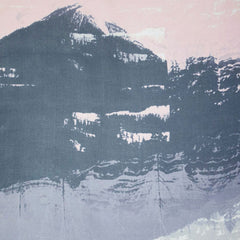Textile Art
 |
Mountain Print The Mountain Print involves layering and blending photographs of the Rocky Mountains to evoke the sense of a continuously moving landscape. Dusky pastel colors are added for a soft alpenglow effect. |
|
|
Landscape Print The Landscape Print captures a topographic view of the Rocky Mountains. The colors of the photographs are intensified and abstracted to the point at which only shadowed outlines of the mountains remain. |
 |
Hybrid Print Inspired by the concept of cross-pollination, the Hybrid Print presents a fantastical vision of hybrid flowers. To create this pattern, images of different flowers are digitally deconstructed and reassembled into a new species. |
|
|
Kinetic Print An interpretation of Alexander Calder's mobiles, the Kinetic Print is an ink painting of dancing figures that captures the lightness and playfulness of the artist's ethos. |
|
|
Fossil Print Colored in chalk, yellow-gold and silvery blue, the Fossil Print is a deconstructed pattern of the rock-like skeleton left behind by coral polyps. |
|
|
Coral Print At the maritime trade gallery in Singapore, a collection of 9th century Tang artifacts had been recovered from a shipwreck. Encrusted with corals, the artifacts expressed new textures that inspired this luminous web-like pattern. |

|
Glide Print On the fourth day of the year, a Cooper's Hawk landed on my balcony. To mark this rare sighting, a symbol of hope and regeneration, I created a sketch of the hawk, colored in fluorescent green and electric blue. |
|
|
Magnolia Print Inspired by the saucer magnolia, a prominent spring flower in Washington D.C., I embroidered a simplified pattern of the magnolia on fabric. The embroidery is then scanned and digitized in tints of dusky rose and blue that add a soft, delicate glow.
|
FABRIC COMPOSITION
Sourced from Japan and South Korea, A.Oei fabrics are mostly composed of natural fibres such as cotton and silk, and regenerated wood-pulp fibres like Tencel-lyocell and viscose. These fabrics are biodegradable and can be safely recycled or broken down at the end of its life cycle.
For garments that require specific functions such as stretch or water-repellent, we may incorporate a minimal amount of synthetic fibres to improve the product quality. These garments are generally outerwear and trousers -- clothing that do not need to be washed as frequently and are meant to be sturdy and fuss-free.





